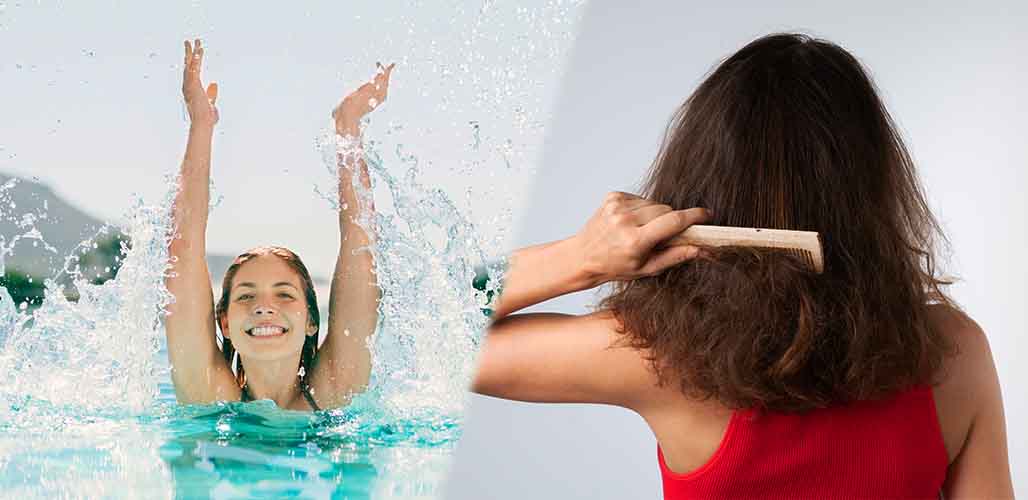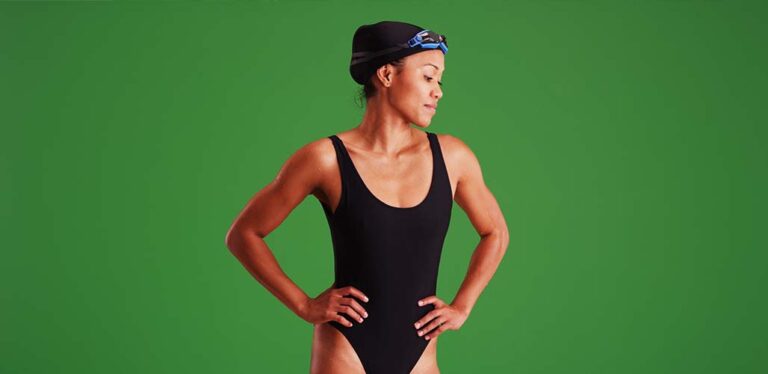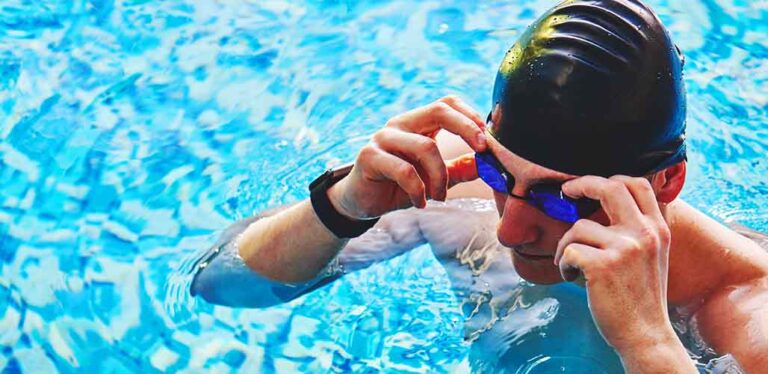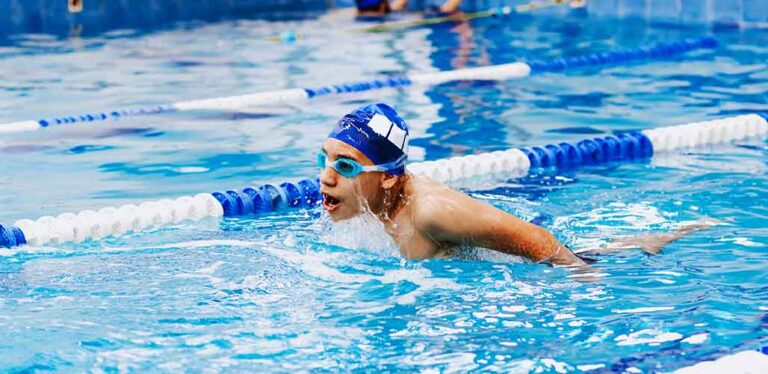How to Brush Tangled Hair After Swimming
Learning how to brush tangled hair after swimming can save you a lot of pain, ripped out hairs, and needless emergency haircuts. Swimming is a great form of exercise, but the chlorine and chemicals present in pool water are harsh on hair. Though this might not seem like a big deal to some, it can make regular swimming quite off putting! Luckily, there are several ways to prevent tangles, knots, and dryness in your hair when swimming.
- Why does my hair get so tangled after swimming?
- How to brush tangled hair after swimming
- Washing your hair after swimming
- How to prepare your hair for swimming
The tips for preparing, detangling, and washing your hair in this guide will help to keep your hair looking its best, even if you’re swimming several times a week.
Why Does My Hair Get So Tangled After Swimming?
Swimming with your hair loose makes it more likely that you’ll experience tangles and knots, especially if you have thick, coarse, or curly hair. As you swim, your hair will twist and wrap around itself, leading to knots. In extreme cases, hair can become very matted after swimming.
Swimming pools contain chlorine and other chemicals to treat the water and make it safer for us to swim in. But, those chemicals are harsh on hair. They will dry out your hair, which makes it more likely you’ll experience knots and tangles. You might also be more prone to tangled hair if you wear goggles, which can actually become tangled in your hair themselves!
Tangled hair should be brushed out after each swimming session to prevent those knots from worsening or turning into matts. However, rushing through this process can make things worse, and can even tug hairs from your scalp.
How to Brush Tangled Hair After Swimming
If your hair is tangled after swimming, it’s important not to rush brushing those knots out. Rushing and dragging your hairbrush through stubborn tangles will only lead to ripping your hair out.
Firstly, make sure you’re choosing the right hairbrush. It’s possible to buy de-tangling hairbrushes, but a wide-toothed comb will work just as well. You can buy detangling spray in most stores, which is a great idea if your hair is particularly bad. Alternatively, choose a leave in conditioner or a hair mineral oil.
Leave the product on for its recommended time before you start brushing through the tangles. As you’re brushing, start at the very ends of your hair and work up towards the root. If possible, split your hair into smaller sections, rather than tackling it as one giant mass of hair.
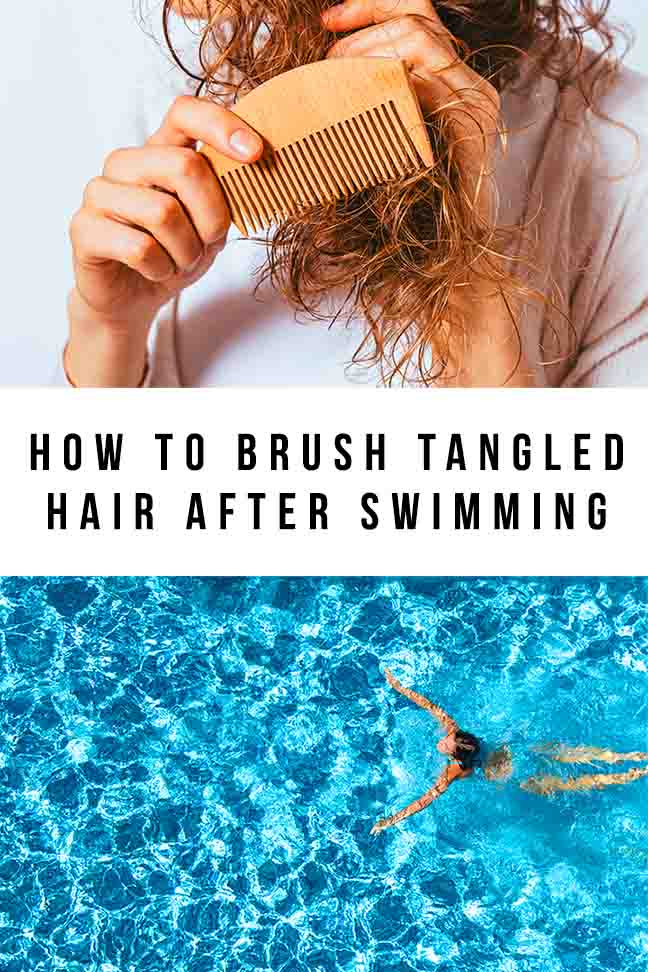
How Do You Untangle Matted Hair After Swimming?
Matted hair is more extreme than regular tangles. In these situations, tangles and knots are more likely to appear as clumps of hair which can range in size, and can be close to the roots or end of your hair. Matted hair is harder to deal with than tangles, and can take a lot more work and time to remove. They are usually the result of tangles and knots that have been left alone, rather than being combed out straight away.
You will need to get a leave in conditioner or detangling spray, and a wide-toothed comb. Put your product in your hair and leave it to soak in. You will likely need more of the product than you would to deal with regular tangles.
When your product has been in for the right length of time, start to comb through the ends of your hair. Work your way up towards the matted hair. Gently tease out the matt, working from the bottom. This might mean getting only a few strands of hair at a time. Don’t tug at the whole thing, as this will be painful and can make the problem worse. The key here is patience. You may need to add more product as you get more hairs free.
Once done, wash out the remaining product. Matts are difficult to get rid of, so it’s best to put the work in before your swim to prevent them in the future.
Is it Better to Brush Hair Wet or Dry?
Wet hair is heavier than dry hair, and will have higher friction when combed than dry hair. Brushing wet hair can cause more damage and breakage than brushing dry hair. So, as a general rule it’s best to brush through your hair when it is dry. However, this can vary depending on your hair type.
Because of this, you may want to let your hair dry a little before brushing it after swimming. Wet hair that has been soaking in chlorinated water will be at its most vulnerable. You can still wash the chlorine out of your hair first, but let it dry at least a little after your shower before you start to brush through any knots and tangles.
Do Swimmers Wash Their Hair Every Day?
Hair washing practices will vary from one swimmer to the next. Some might wash their hair after every pool session, but others might only wash it a few times a week. Either way, most swimmers will at least rinse through their hair after swimming to remove as much chlorine as possible and minimise damage. People with very fair hair can find that the copper in swimming pools turns their hair green, so washing it after every swim can help to prevent this issue.
Washing your hair every day isn’t recommended by many haircare professionals. But, chlorine can do a lot of damage to hair. So, it’s better to get it all out after swimming sessions. Instead of skipping hair washes, you should consider using a milder shampoo. You can also find products specifically dedicated to removing chlorine from hair after swimming.
And, if that option still does not appeal to you, there are ways you can prepare your hair before swimming to reduce the amount of chlorine that your hair picks up.
Preparing Your Hair for Swimming
Proper hair care and preparation before you get into the pool can go a long way to preventing tangles, or at least making them easier to comb through.
Before swimming, brush or comb through your hair to remove any tangles. Wet your hair thoroughly. Hair is porous, so it can help to saturate it with non-chlorinated water before your swim, to prevent it from soaking up as much pool water. After it’s thoroughly soaked, add a leave in conditioner or similar hair product. Some people prefer oils, like coconut oil, but you can choose what works best for your hair.
Once you’ve prepared your hair with a quick shower and the right products, you can tie up your hair to stop it from moving around as much whilst you’re swimming. Alternatively, some people prefer to use shower caps over their dry hair, but if they are too tight they can rip hairs out of your hair line. Alternatively, if they are too loose, chlorinated water will seep in and get in your hair.
Should I Tie My Hair Back When Swimming?
There are a couple of benefits to tying back long hair when swimming. Firstly, it can help to prevent your hair from becoming so tangled. But, it will also keep it out of your way when swimming, which is particularly helpful if you’re swimming lengths or submerging your head a lot.
There are a few options for you if you want to tie your hair back, and it will partly depend on your hair type. You could tie all of your hair into a bun on top of your head. This is a popular style for keeping hair tucked under a swimming cap. Alternatively, you might choose to braid your hair, letting it fall down your back. Or, you might coil your hair into smaller buns. The best style for you will depend on the type of hair you have, as well as the length and thickness.
How to Brush Tangled Hair After Swimming – A Summary
Brushing your hair after swimming is important to stop any knots and tangles from turning into matted hair. Products like detangling spray and leave in conditioner can really help to ease out any knots. But, patience is key to brushing through tangled hair after swimming. And, proper preparation before you swim can really help to reduce the number of tangles afterwards!
Do you have any tips or tricks for getting rid of knots in hair after swimming?
Learn More About Swim Style
- Prevent dry hair after swimming
- Are wetsuits comfortable?
- Should you wear shoes in the ocean
- Do swimsuits get looser in the water?
- Is it easier to float in the sea?
References and Resources
- Biel et al. ‘Green Hair Caused by Frequent Swimming Pool Use’, Der Hautzart (1997)
- Rajput, R. ‘Understanding Hair Loss due to Air Pollution and the Approach to Management’, Hair: Therapy and Transplantation (2015)
- Robbins & Kamath. ‘Hair Breakage During Combing. IV. Brushing and Combing Hair’, Journal of Cosmetic Science (2007)
- Sinclair, R. ‘Healthy Hair: What is it?’ Journal of Investigative Dermatology Symposium Proceedings (2007)

